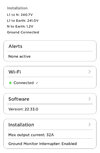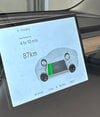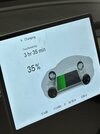I am sorry to bust your balls, but that doesn't make sense to me.
Then get your facts right, and it will make sense, and you won't need to resort to being insulting.
All the early Model S that came with a dual 11kw (total of 22kw) chargers were single phase and using the Tesla plug both in the US and the EU.
That is false.
I'm going to allow the courtesy that maybe you are talking about an obscure situation where some individual in Europe was really passionate about this and bought a U.S. spec Tesla and then had it shipped over to Europe before Tesla ever began selling them in that continent. That is the only way your statement could be true. Tesla waited a long time to begin selling in Europe to avoid this very situation you're describing (which didn't happen). They would not ship cars there that couldn't use the commonly available 3 phase power and which had a proprietary port that did not match all of the existing public charging infrastructure. That just didn't happen. They used a modified Mennekes port on the cars, that was usable by the public Type2 cables, and they made their Supercharger plugs with that plug type too, so they could use just the one port on the car. So no, Tesla did not sell cars in the EU that had the Tesla proprietary port.
And the cars had their internal chargers configured differently than the ones they built for North America. They were differently wired internally so they could use 3 phase. This was actually a source of some irritation for some European owners because the chargers were not made with dynamic detection and switching inside, so if they were trying to use a high amp single phase source, it really couldn't pass through much current and was limited to pretty low levels, with effectively only being able to use a third of the charger.
The 3 phase HPWC Gen 3 the OP mentions is a 3 phase with the EU level 2 charging plug (
type 2) everybody in EU uses (not the aforementioned Model S)
The Model S DID come with that Type 2 port!
and it has 4-5 (1 is ground) power conductors so it could be used with a 3 phase power (unlike the aforementioned Model S).
The Model S WAS built to use 3 phase!
So according to you, how in the world is the 3 phase 22KW made to be used with a single phase 22kW Model S OBC?
The basis for your previous assumptions are incorrect. As I mentioned, the European Model S cars DID come with differently configured internal chargers that were built to use 3 phase. They were not single phase for the cars sold in Europe. So the Model S and the Model X could use pretty high levels of power on 3 phase. When the X came out, they had redesigned the chargers some, so they could only do about 17 kW, and when the Model S got the refresh in early 2016, it also moved over to that new style of charger that could do 17 kW, but both were still configured for 3 phase for the ones built for Europe. And I think at that point was when they designed in the ability to detect and switch if they were getting a high amp single phase input instead of being limited to just a third of the power use.
Again you are correct if you are using the HPWC Gen 2 installed on a 100A circuit with a nominal current 80A (consistent load for more than 15min should be no more than 80% of circuit's ampacity).
The constant load definition is a lot longer than 15 minutes. But regardless, in the 2017 NEC version, they removed that potential loophole by defining that ALL charging for EVs must be considered constant load for these circuit calculations.
And yes - the Gen 3 single phase maxes at 11KW, but the 3 phase is capable of 22KW.
Maybe you're saying something accurate here, but it's a little unclear what you are saying. You mention "Gen 3". You mean Tesla's Gen 3 wall connector? Yes. Comparing it to the Gen 2? The Gen 2 was made in both versions, since they needed to offer it in both North America and Europe, and yes, they were about 22 kW capable Since the U.S. version was only single phase, it didn't quite get to use all that capacity, since it was effectively limited to about 240V x 80A, so it was about 19.2 kW.
Once again - the model 3 (if I can judge from mine) has an OBC that maxes at 13KW, with 11KW being given in the specs. So that's what we have now.
Sure, this is true.
Correct me if I am wrong, I think I covered it pretty big detail.
Oh, I did. I have been following this stuff about daily since 2013, so I remember the history and progression of it quite well.
Ah, you can take a look at the Gen 3 here, both single and 3 phase:
Tesla HPWC Gen 3 Single phase
Tesla HPWC Gen 3 3PT2 - See page 9, POWER OUTPUT. It is not for the US market and it's not available to buy in the US
Tesla Model 3 manual (GB) -CHARGING INSTRUCTIONS -> CHARGE SETTINGS towards the end:
So rough calculation - 230V*32A=7.4KW, times 3 for the 3 phases - 22KW. Now the question is "Which region is that?"
Two things: I'll answer the second question first.
1) "Which region is that?" That's Europe or Australia or the types of regions that use Type 2 cables for their charging infrastructure, which generally overlaps with 3 phase being commonly available. Any version of their wall connectors that is built for 3 phase and with a Type 2 cable is for that.
2) The 22 kW part. Now the second part is just a great bit of comedy of Tesla's incompetence of documentation. They fill in the rest of the table of charging power with math just to make it look pretty and not leave any blank spaces. But I am over 99% sure that the smaller, less capable, lower power Gen 3 version of the wall connector DOES NOT have the capability of providing 22 kW charging power from 3 phase or from any kind of source. Tesla is kind of notorious for copying over documentation from previous sources, which is wrong on the new equipment.
For instance, they had a table of the recharging speeds in rated miles per hour of the cars on various charging sources. On the old, heavy, inefficient Model S, that was listed as 3 mph on a 120V 12A supply. That was accurate. Several years later, when the Model 3 came out, which was much more efficient, they copied over the table and adjusted most of the values, but forgot to adjust the one for 120V 12A, so it still said 3 mph, which is just hilariously wrong, but has confused a lot of people. It still says 3 mph on Tesla's website to this day, and it's unlikely they will ever bother to fix it. So that's why the Gen 3 wall connector got that 22 kW copied over from the Gen 2 documentation but was not corrected to eliminate it since the Gen 3 can only do about 12 kW.
So no hard feelings, but feel free to listen to someone who has been following this for a really long time and does know about the history of Tesla's equipment.





